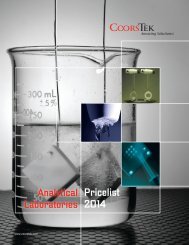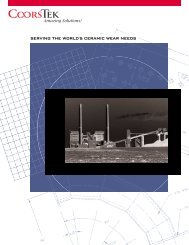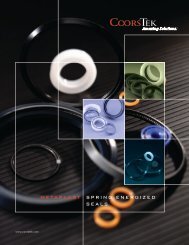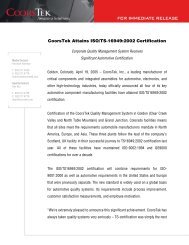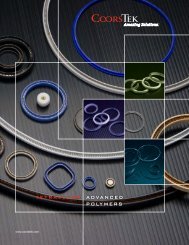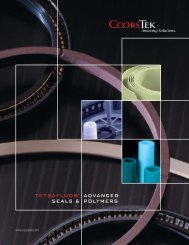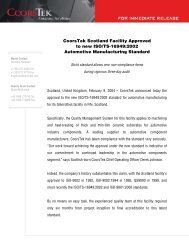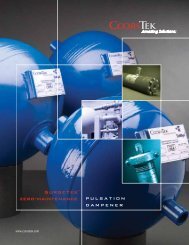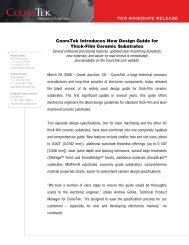t h i c k - f i l m ceramic substrates design guide - CoorsTek
t h i c k - f i l m ceramic substrates design guide - CoorsTek
t h i c k - f i l m ceramic substrates design guide - CoorsTek
Create successful ePaper yourself
Turn your PDF publications into a flip-book with our unique Google optimized e-Paper software.
Camber Test Method: <strong>CoorsTek</strong> <strong>substrates</strong> are 100% inspected for camber using two ground,<br />
parallel plates spaced at a fixed distance by the following formula:<br />
Camber distance setting, D = T + [C x L], where:<br />
T = nominal substrate thickness<br />
C = camber (inches per inch or mm per mm)<br />
L = substrate length or longest outside dimension<br />
English example:<br />
For a 4.0" x 3.5" x 0.025" substrate:<br />
Nominal substrate thickness, T = 0.025"<br />
Camber, C = 0.003" per inch<br />
Longest outside dimension, L = 4.0"<br />
Camber distance setting,<br />
D = 0.025" + [0.003" per inch x 4.0"] = 0.037"<br />
D = T + (C • L)<br />
camber<br />
distance<br />
setting<br />
substrate<br />
mode of<br />
thickness<br />
camber<br />
value<br />
substrate<br />
length<br />
Metric example:<br />
For a 101.6 mm x 88.9 mm x 0.635 mm substrate:<br />
Nominal substrate thickness, T = 0.635 mm<br />
Camber, C = 0.003 mm per mm<br />
Longest outside dimension, L = 101.6 mm<br />
Camber distance setting,<br />
D = 0.635 mm + [0.003 mm per mm x 101.6 mm] = 0.9398 mm<br />
To inspect for camber, parallel plates are set at a 45º angle with a gap equal to the D value<br />
determined in the formula. Substrates that pass through the gap under their own weight are<br />
acceptable. Camber bar sets are available for purchase from <strong>CoorsTek</strong>.<br />
Hole Sizes and Shapes: Hole diameters and shapes are verified using computer-enhanced optical<br />
measuring with top or back light equipment or pin gauges. Method of hole verification will be<br />
chosen for best correlation on hole size between <strong>CoorsTek</strong> and customer.<br />
Hole Locations: <strong>CoorsTek</strong>’s standard procedure for inspection of hole locations is computerenhanced<br />
optical measuring equipment on the entry side using top light.<br />
Scribe Lines:<br />
Before Break: Scribe line locations are inspected using computer-enhanced optical<br />
measuring equipment.<br />
After Break: The part segments are inspected with digital calipers.<br />
Chips: Inspection for chips is done under a high-intensity, low-angle light using the unaided eye.<br />
Part Features: Location and size of part features are inspected with computer-enhanced optical<br />
measuring equipment.<br />
Pulse Depth: Average laser pulse depth is inspected on a substrate cross section using enhanced<br />
optical methods at a magnification of 30x. The average is determined over a minimum of 10<br />
adjacent pulses.<br />
Pulse Spacing: Average laser pulse spacing is inspected using enhanced optical methods at a<br />
magnifi cation of 30x. The average is determined over 11 adjacent pulses.<br />
Slag Height: Slag height is inspected with a micrometer and is not to exceed 0.001"<br />
(0.025 mm) in height.<br />
Cracks: Inspection for cracks is performed using a dye penetrant or other appropriate techniques.<br />
For expert<br />
assistance with<br />
your next project,<br />
please call:<br />
+1.800.799.1457<br />
in North America<br />
Thick Film



